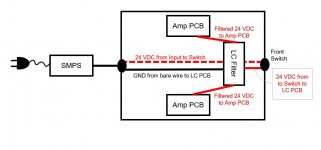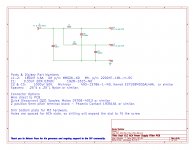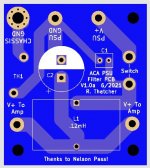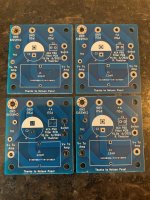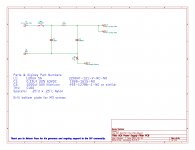MJ: Thanks for the smart advice. Have already ordered only 2 because their agent suggested a smaller number would yield faster shipping. Next time, however...
AND need to stress to you that I selected the M2X for my next DIY project because of your exceptional thread describing your design, development, and build of the amp. It is a brilliant concept to have alternate daughterboards allowing for multiple amp results. You should be acknowledged for this level of thought and accomplishment.
Was wondering initially if there might be a way to make all 5 boards "switchable" so you could quickly shift between each. Once the boards came, it is obvious that the daughterboard is a single, fixed element of the main board and, so, I assume this cannot be done.
Your thoughts on a good PCB and PSU selection for an outboard box would be greatly appreciated.
Also, am confused about the "push-pull" amp design and the class A board option. Can push-pull be truly class A if the signal has a crossover point? Pardon me if I am confused once again.
AND need to stress to you that I selected the M2X for my next DIY project because of your exceptional thread describing your design, development, and build of the amp. It is a brilliant concept to have alternate daughterboards allowing for multiple amp results. You should be acknowledged for this level of thought and accomplishment.
Was wondering initially if there might be a way to make all 5 boards "switchable" so you could quickly shift between each. Once the boards came, it is obvious that the daughterboard is a single, fixed element of the main board and, so, I assume this cannot be done.
Your thoughts on a good PCB and PSU selection for an outboard box would be greatly appreciated.
Also, am confused about the "push-pull" amp design and the class A board option. Can push-pull be truly class A if the signal has a crossover point? Pardon me if I am confused once again.
Think I understand now -- that is not a PSU but a CLC filter in rhthatcher's post, right? So the Meanwell goes directly to that and then to the PCB?
I'm attaching a pic of the concept. The SMPS feed runs through the input jack to the switch, then to the LC filter board, then splits into one LC filter per channel, then feeds each amp board.
Attachments
Very clear, rhthatcher and thanks again.
Am assuming that each half can be separately wired for an individual smps and, so, the one board will serve for our 2-smps build.
So put me down for 2 if you decide to sell a few. Like the idea of a complete kit a bunch.
Am assuming that each half can be separately wired for an individual smps and, so, the one board will serve for our 2-smps build.
So put me down for 2 if you decide to sell a few. Like the idea of a complete kit a bunch.
Last edited:
rthatcher: actually, if you make these available I will try one per board on my dual-smps build!
The board in the amps I just build is set up for single SMPS.
I made some "Rev 1.0a" versions that are basically the same as the VFET CLC board. For a Dual SMPS build you could use 2 of those, one per SMPS/Amp board.
Alternatively, I could make the next run of boards with 2 inputs and users would need to insert a jumper for 1 SMPS amps.
For this smaller board...
Ignore the Thermistor (leave it out, ACA is tied to ground at Amp boards already)
Only hook up one amp V+ connection on each board.
Drop power from the ACA front switch into switch hole by the "2021" text. You already have wire running from back of the amp to the switch - leave it alone...
Attachments
rthatcher: looks great awesome work!
Craigl59: thanks for the tips for DI's I'll pass them along. Eric is 8-10 weeks out on delivery! I think the Lore's would work great with the ms-aca.
TA: Thanks, I think the F6 will be my next build, it will be a great opportunity to learn linear supplies too.
Mosfet listening update: I have both amps set up for dual-smps. Running two meanwells makes a big difference. I noticed the bias bumped up by .2 when I made that change. I brought it back down to 12.4.
In one amp I have FQH44N10's at Q1 and Q2, in the other I have the IRFP140 at Q2 and still the FQH at Q1.
The amps sound remarkably different, I call the full FQH amp "Too much of a good thing" after TA's prediction. It has huge bass and a liquid midrange, amazing with vocals and a natural high end, very smooth but still with a lot of detail. No fatigue with this setup.
The amp with the 140 at Q2 is a little lighter and faster sounding, with lots more air on top. Lighter through the mids and more attack and less body on the acoustic bass. Much more bite on the brass and clarity on the piano. This is the configuration I would use if I was going to parallel mono.
I wonder if it might make sense to take the parallel film caps off of R12 on the full FQH amp, it never even thinks about sounding hard on top. Might they roll it off where it might not need it?
Craigl59: thanks for the tips for DI's I'll pass them along. Eric is 8-10 weeks out on delivery! I think the Lore's would work great with the ms-aca.
TA: Thanks, I think the F6 will be my next build, it will be a great opportunity to learn linear supplies too.
Mosfet listening update: I have both amps set up for dual-smps. Running two meanwells makes a big difference. I noticed the bias bumped up by .2 when I made that change. I brought it back down to 12.4.
In one amp I have FQH44N10's at Q1 and Q2, in the other I have the IRFP140 at Q2 and still the FQH at Q1.
The amps sound remarkably different, I call the full FQH amp "Too much of a good thing" after TA's prediction. It has huge bass and a liquid midrange, amazing with vocals and a natural high end, very smooth but still with a lot of detail. No fatigue with this setup.
The amp with the 140 at Q2 is a little lighter and faster sounding, with lots more air on top. Lighter through the mids and more attack and less body on the acoustic bass. Much more bite on the brass and clarity on the piano. This is the configuration I would use if I was going to parallel mono.
I wonder if it might make sense to take the parallel film caps off of R12 on the full FQH amp, it never even thinks about sounding hard on top. Might they roll it off where it might not need it?
Zj27: Your musical analyses are always precise and helpful; keep them coming.
Have the all FQH build and agree with your assessment with one major difference: my system's bass is just right with full extension into the 30s (maybe lower) and accurate levels to other voices.
Last night was testing this with 2 digital sources I use for bass response: the cut "Tarnation" from the Thile/Meyer album "Bass & Mandolin" and the famous Wooten solo from "Flight of the Cosmic Hippo." Superb evenness through the entire range of Meyer's DB and Wooten's instrument sounds accurate and real-world. Noted as you say above that the body of the acoustic DB was better represented than with my Emotiva XPA-1 and the MS ACA is a significantly better amp for bass than the 300Bs (bass lack in 300bs is well known).
SO would suggest you consider the possibility that some of the listening results you hear are the result of your speaker and, as you noted above, your room. In the very large listening area I have here low frequencies can extend naturally throughout their entire wavelength and, so, very low passages will appear and be natural whereas they get bounced about and/or truncated in much smaller spaces.
And my acid test for low frequencies is the cut "Down that Road Again" by the Steep Canyon Rangers (="Radio"). In the second repeat of the chorus, the bass player drops a passage down an octave in dramatic fashion and your amp, speakers, and room have got to go all the way to capture this gesture -- it blows me away when it is done right.
Take both of your ACA builds to your friend's DI when he gets it and see what that speaker tells you about the ACA bass response. AND, also, tell your friend that he can push the DIs as close to the wall as he wants -- JUST as long as he damps the back port. Owners talk about needing to move the speaker miles away from walls but this is nonsense. It is the low, back port that causes this need in their eyes. Foam will kill this phased-reversed garbage and so much the better.
Have the all FQH build and agree with your assessment with one major difference: my system's bass is just right with full extension into the 30s (maybe lower) and accurate levels to other voices.
Last night was testing this with 2 digital sources I use for bass response: the cut "Tarnation" from the Thile/Meyer album "Bass & Mandolin" and the famous Wooten solo from "Flight of the Cosmic Hippo." Superb evenness through the entire range of Meyer's DB and Wooten's instrument sounds accurate and real-world. Noted as you say above that the body of the acoustic DB was better represented than with my Emotiva XPA-1 and the MS ACA is a significantly better amp for bass than the 300Bs (bass lack in 300bs is well known).
SO would suggest you consider the possibility that some of the listening results you hear are the result of your speaker and, as you noted above, your room. In the very large listening area I have here low frequencies can extend naturally throughout their entire wavelength and, so, very low passages will appear and be natural whereas they get bounced about and/or truncated in much smaller spaces.
And my acid test for low frequencies is the cut "Down that Road Again" by the Steep Canyon Rangers (="Radio"). In the second repeat of the chorus, the bass player drops a passage down an octave in dramatic fashion and your amp, speakers, and room have got to go all the way to capture this gesture -- it blows me away when it is done right.
Take both of your ACA builds to your friend's DI when he gets it and see what that speaker tells you about the ACA bass response. AND, also, tell your friend that he can push the DIs as close to the wall as he wants -- JUST as long as he damps the back port. Owners talk about needing to move the speaker miles away from walls but this is nonsense. It is the low, back port that causes this need in their eyes. Foam will kill this phased-reversed garbage and so much the better.
Regarding the feedback resistor R12 and it’s bypass capacitor C101 of the modified ACA: I chose the RC time constant to match that of the Zen v4. The corresponding cutoff frequency is about 175 kHz. The type of capacitor may have a small effect. First choice would be film*, second choice silver mica. Avoid ceramic, even NPO/C0G could have adverse sonics.
* polypropylene or polystyrene
* polypropylene or polystyrene
Last edited:
FYI: Edcor shipped the 2 transformers for the M2X today, in less than 24 hours from order. So ignore their website disclaimer of "8 weeks delivery time" when you order from them and just call up their rep directly to get the accurate shipping story.
Was wondering initially if there might be a way to make all 5 boards "switchable" so you could quickly shift between each.
Dirk made a lovely setup for switching between the IPSs. I'm sure he'd share details.
https://www.diyaudio.com/forums/pass-labs/321925-diyaudio-watt-m2x-488.html#post6601738
If this does not take you directly to the post, it is #4880 in the M2x thread.
Have fun! It's a fantastic project and was my first First Watt clone build.
and the famous Wooten solo from "Flight of the Cosmic Hippo."
😀 😀
tell your friend that he can push the DIs as close to the wall as he wants -- JUST as long as he damps the back port. Owners talk about needing to move the speaker miles away from walls but this is nonsense. It is the low, back port that causes this need in their eyes. Foam will kill this phased-reversed garbage and so much the better.
That is an exceptional tip, and something that I had not considered. Placement of my DIs has been a PITA to say the least. I don't have an ideal room, and I have one node that I just can't fix. I'll try your tip. Thanks!

IAIMH: Thanks so much for the kind visuals...
Another point about the back port -- don't try and stuff foam directly into the port; this will dampen the woofer movement and make all worse. I get a 2'X3' sheet of 4" foam, cover it with speaker cloth, then position it on a support right behind the port. Works great. And from the studio world...as many first-reflection reverberations as you can kill in your listening room, the better the soundstage will become. This is because reflected music interferes with the clarity of the L/R balance created during the mix process. I use large sound absorbent wall panels behind the DIs, also covered in black speaker cloth.
NOW if I can only find the last back-ordered components for the M2X, I can get all ordered. Anyone know where the Male Faston 1/4" Blades can be found? Or the 10uf, 50v, NP capacitor? Managed to get all the rest although several are creative alternates. Going to check on post 4880 now -- thanks for the tip.
Another point about the back port -- don't try and stuff foam directly into the port; this will dampen the woofer movement and make all worse. I get a 2'X3' sheet of 4" foam, cover it with speaker cloth, then position it on a support right behind the port. Works great. And from the studio world...as many first-reflection reverberations as you can kill in your listening room, the better the soundstage will become. This is because reflected music interferes with the clarity of the L/R balance created during the mix process. I use large sound absorbent wall panels behind the DIs, also covered in black speaker cloth.
NOW if I can only find the last back-ordered components for the M2X, I can get all ordered. Anyone know where the Male Faston 1/4" Blades can be found? Or the 10uf, 50v, NP capacitor? Managed to get all the rest although several are creative alternates. Going to check on post 4880 now -- thanks for the tip.
My pleasure. Thank you for the tips!
I am hardheaded. Even though I have read far too many times over too many years that proper room treatments are critical, I just don't get off my butt to do it. Well, now I know I will.
See M2x thread for some parts.

I am hardheaded. Even though I have read far too many times over too many years that proper room treatments are critical, I just don't get off my butt to do it. Well, now I know I will.
See M2x thread for some parts.

Warning subjectivity ahead! I tried out the dual CLC filters from rthatcher in my ACA monos. I do not have the premium parts version of the ACA’s, but I do have a well appreciated pair of 1.6’s. Three days in of listening and they seem a bit more 3D. Which for my particular tastes is a nice little mod. I’m curious what others that try it thoughts are.
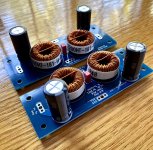
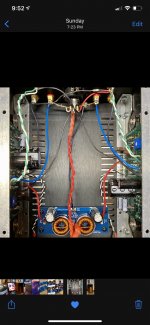
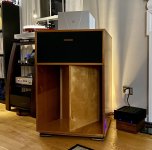



I have some PM's and some requests in the thread for the filter boards/kits. I worked up a group buy. See the following on the Group Buy forum:
https://www.diyaudio.com/forums/group-buys/376245-gb-aca-power-supply-filter-kits.html#post6764973
https://www.diyaudio.com/forums/group-buys/376245-gb-aca-power-supply-filter-kits.html#post6764973
^ This looks like a well thought-out addition to the ACA. 
If I am not mistaken, it looks like it could be used in the VFET amp as well, offering some filtering that is independent for each channel.

If I am not mistaken, it looks like it could be used in the VFET amp as well, offering some filtering that is independent for each channel.
Last edited:
I really enjoy this thread and the dedication of all the people here with suggestions, filter constructions and listening impressions.
I have only one ACA, so can not do any resonable A/B tests. Anything I has to tell has to be taken with a big grain of salt.
I'm currently using the FQH44N10 in the output stage, don't have any other transistors to use for now. When I checked a week ago Mouser.se had one (1) IRFP140 in stock.
One thing I found is that halving the values for the gate stoppers to 60 ohms did a positive difference in the sound in making it more open. No real difference was seen when doing distortion measurements with that value. I also changed the values to 40 ohms but that caused a frizzy sound at the higher frequencies. It was clearly visible in the noise/distortion profile of the ACA.
Also using a filter like the one rhthatcher suggested will clearly lower the distortion at lower frequencies (compared to a lower induktor value filter). I have not done any special listening tests with or without filters, but are relying on separate filters for each channel followed by a bigger cap after that filter.
I truly think this solution improves channel separation enough to not warrant double SMPS for the ACA.
But of course, I have been wrong so many times...
I have only one ACA, so can not do any resonable A/B tests. Anything I has to tell has to be taken with a big grain of salt.
I'm currently using the FQH44N10 in the output stage, don't have any other transistors to use for now. When I checked a week ago Mouser.se had one (1) IRFP140 in stock.
One thing I found is that halving the values for the gate stoppers to 60 ohms did a positive difference in the sound in making it more open. No real difference was seen when doing distortion measurements with that value. I also changed the values to 40 ohms but that caused a frizzy sound at the higher frequencies. It was clearly visible in the noise/distortion profile of the ACA.
Also using a filter like the one rhthatcher suggested will clearly lower the distortion at lower frequencies (compared to a lower induktor value filter). I have not done any special listening tests with or without filters, but are relying on separate filters for each channel followed by a bigger cap after that filter.
I truly think this solution improves channel separation enough to not warrant double SMPS for the ACA.
But of course, I have been wrong so many times...
I think there is a lot more going on with the dual-smps than just channel separation. To me it has a lot of the benefits of running parallel monoblocks but maintains whatever makes it special in stereo mode... that is a terribly subjective statement. I do think having tried a couple of different transistors that the FQH44N10 is really special in this amp, I have one with it in both Q1 and Q2 and another with a 140 in Q2, the one 140 is lighter and brighter even just in Q2. I have 6 140's if anyone needs them, would pass along at cost. Which resistors are the gate stoppers?
About double SMPS... I guess I will find out the difference at one time. It is hard to imagine what it is about.
Gate stopper resistors are Dale 1/2 watt CFM55 as is most of the resistors in the signal path.
Gate stopper resistors are Dale 1/2 watt CFM55 as is most of the resistors in the signal path.
Just got the second dual-smps build finished and here is the news.
First, rhthatcher's dual-pole front switch works fine with one oddity. There is a groove on the ACA frontplate for the ridge in the switch housing to fit into and it only seats one way. With the switch oriented with the groove, the on-off movement is reversed. Down is ON and up is OFF. No way to adjust this by wiring or a different fit. Takes a while to get used to, but no problem -- and one switch turns on both SMPSs. the symbols on the switch remain accurate -- the circle is off and the line is on.
The unit turned on and worked fine from the start. Adjusted the bias to 12.5 volts for each channel to the Tekton DIs and the sound is mostly the same as the first DS ACA. Being a new amp, you can tell a very, very light "tight" or "plastic" character that wears off with usage. Same as the 1st ACA.
More surprisingly, this amp is definitely louder than the first one. Have been running some set-volume sources into it that I am used to with the first unit and the new build is clearly 3-5dB louder. Don't know why, for sure.
The only component changes made were Vishay/Dale resistors. Perhaps more telling, my first ACA was subjected to trying to bias with no load affixed. Didn't seem to cause any damage and both units are biased to 12.5 volts.
But it's the same amp and sounds the same "class A' way: great soundstage, superb dynamic naturalness, and good tonality.
These kits are over-the-top good at working right out of the workshop and the only problems I have had with both are the somewhat clumsy nature of bolting the parts together at the end -- requires a little ingenuity as the bolts are hard to seat and get to.
First, rhthatcher's dual-pole front switch works fine with one oddity. There is a groove on the ACA frontplate for the ridge in the switch housing to fit into and it only seats one way. With the switch oriented with the groove, the on-off movement is reversed. Down is ON and up is OFF. No way to adjust this by wiring or a different fit. Takes a while to get used to, but no problem -- and one switch turns on both SMPSs. the symbols on the switch remain accurate -- the circle is off and the line is on.
The unit turned on and worked fine from the start. Adjusted the bias to 12.5 volts for each channel to the Tekton DIs and the sound is mostly the same as the first DS ACA. Being a new amp, you can tell a very, very light "tight" or "plastic" character that wears off with usage. Same as the 1st ACA.
More surprisingly, this amp is definitely louder than the first one. Have been running some set-volume sources into it that I am used to with the first unit and the new build is clearly 3-5dB louder. Don't know why, for sure.
The only component changes made were Vishay/Dale resistors. Perhaps more telling, my first ACA was subjected to trying to bias with no load affixed. Didn't seem to cause any damage and both units are biased to 12.5 volts.
But it's the same amp and sounds the same "class A' way: great soundstage, superb dynamic naturalness, and good tonality.
These kits are over-the-top good at working right out of the workshop and the only problems I have had with both are the somewhat clumsy nature of bolting the parts together at the end -- requires a little ingenuity as the bolts are hard to seat and get to.
Last edited:
Craig59: Bias tuning without load is no different than tuning with a load on the output. The ACA is AC coupled, no bias current can flow through the speakers.
The input on the other hand is different, it is resonable high input impedance so stray noise can affect the bias current in a small way. I use a shorted male phono plug or verify that the source is turned off when adjusting bias.
The input on the other hand is different, it is resonable high input impedance so stray noise can affect the bias current in a small way. I use a shorted male phono plug or verify that the source is turned off when adjusting bias.
- Home
- Amplifiers
- Pass Labs
- ACA amp with premium parts
